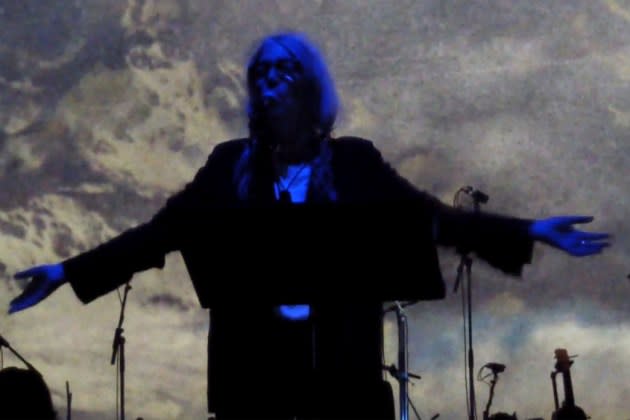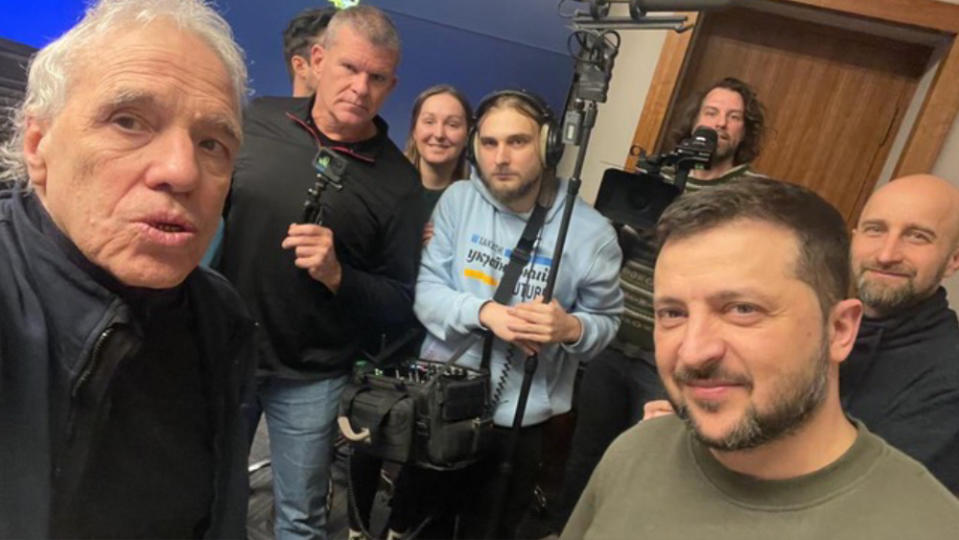Abel Ferrara Talks Ukraine War Documentary ‘Turn in the Wound,’ the Nature of Evil and Why the Conflict Isn’t ‘Yesterday’s News’

Abel Ferrara has made a career out of staring unflinchingly into the abyss, interrogating man’s weakness and depravity and daring his audiences to look away. Faced with the catastrophic violence of the war in Ukraine, however, which he chronicles in the Berlin-premiering documentary “Turn in the Wound,” even the iconoclastic director finds himself at a loss — for words, and for easy answers.
“Why is the violence — that’s what it’s about,” Ferrara tells Variety. “Whether it’s there, whether it’s happening in Gaza and Israel — it’s happening all over the world. It has happened, it is happening, and it’s going to happen, and the question is, Why?”
More from Variety
Ferrara returns to Berlin four years after competing for the Golden Bear with “Siberia,” which starred Willem Dafoe in what Variety’s Guy Lodge described as a “beautiful, unhinged, sometimes hilarious trek into geographical and psychological wilderness.” The prolific filmmaker has hardly sat idly by in the interim, launching his COVID video diary “Sportin’ Life” at the Venice Film Festival that same year, appearing in Locarno in 2021 with his pandemic thriller “Zeros and Ones,” starring Ethan Hawke, and returning to the Lido in 2022 with “Padre Pio,” a religious biopic of the titular 20th-century saint starring Shia LaBeouf.
The Bronx native, who turns 73 this summer, is perhaps enjoying his most productive stretch since the nineties, when he released eight films in the span of nine years, including several career-defining descents into the lurid underbelly of his hometown, like “King of New York” and “Bad Lieutenant.” With “Turn in the Wound,” Ferrara — who moved to Rome shortly after the Sept. 11 terrorist attacks — proves himself to be no less interested in the dark corners of the soul. But whereas the younger director made his name on shlock-and-awe provocations like “The Driller Killer” and “Ms. 45,” “Wound” finds him working in a more sober register. Chronicling the atrocities committed during Russia’s war in Ukraine, there is no need to dial up the violence.

“I’m an instinctual filmmaker, so I just felt I need to be here now, with my camera, in a humble way,” Ferrara explains to a Ukrainian journalist who’s interviewing the director for a TV news segment during the film. Speaking to Variety, he elaborates. “We shoot documentaries. I want to know.” He stops short to rephrase his thoughts. “Knowing things is a little — you never really know anything. I want to put the camera on. I want to witness it.”
The compulsion to bear witness is what brought Ferrara to Ukraine just months after the Russian invasion in February 2022, arriving that summer with a small crew that included cameramen Emmanuel Gras and Sean Price Williams and long-time collaborator Phil Neilson. They returned in the fall of 2023 to interview President Volodymyr Zelenskyy and the soldiers who had been fighting on the frontlines. The production was far from what Ferrara describes as the “moment-to-moment nightmare” on the war’s eastern front, but in his interviews with survivors, the specter of death is ever present — even, literally, in the air they breathe, as one woman chillingly recounts.
“Our way of making movies, we put the camera there and let people tell their stories,” Ferrara says, describing the fly-on-the-wall approach he brought to documentaries including “Chelsea on the Rocks” (2008), “Napoli Napoli Napoli” (2009) and “Piazza Vittorio” (2017). “I’m just learning through the process of making a documentary film. We just get in there. I’m not asking a lot of questions. Because people have a story to tell.”
Unlike Sean Penn’s gonzo war documentary “Superpower,” which followed Zelenskyy’s sudden ascent from leading man to wartime general and premiered at the Berlin Film Festival last year, “Turn in the Wound” only gives the Ukrainian leader around 10 minutes of screen time — though time enough, Ferrara suggests, for the audience to get a whiff of his “Thomas Jefferson vibe.” Soon after, the director interviews a wounded soldier who recounts how he miraculously survived a Russian attack that decimated his unit, drinking rainwater from a muddy puddle until his comrades could rescue him.

“How many losses? How many victims? And for what then?” the soldier replies, when asked if he would accept a potential peace deal that would hand the Ukrainian territories of Donbas and Crimea over to Russia. “This is ours, ours by right. People have been born and lived here for generations. Why must we give this away? It shouldn’t be like this, and we have already paid too high a price.”
As the world’s attention wanes from the two-year-old war in Ukraine, Ferrara is asked if he feels a renewed sense of urgency to remind people of the conflict’s stakes. The director bristles at the suggestion.
“What’s happening there on a day-by-day level, you don’t need a film to renew interest,” he says. “It’s not a matter of interest. What’s happening there is — from the soldiers to the people we talked to, even the leaders, it’s clear cut. They’re fighting for independence. They’re fighting for freedom. This concept of freedom is very clear to these cats. That’s what our country is based on,” he continues. “Freedom isn’t something you just take for granted. And obviously, these kids…know what they’re fighting for. It’s not going to get stale. It’s not yesterday’s news. It’s up front.”
The director’s most striking choice in “Turn in the Wound” is to pair his interviews and war footage with a performance by singer, songwriter and poet Patti Smith, who combines her own lyrics and poetry with texts from writers including Antonin Artaud, René Daumal and Arthur Rimbaud (a line from whose poem, “Memory,” lends the film its title). Smith’s spoken-word recital, which Ferrara had originally filmed for a separate documentary, is set against a heavy, doom-laden score while abstract images project onto a giant screen behind her in Paris’ Center Pompidou.
For Ferrara, those performances are an entry point into a broader moral universe, a way for him to grapple with eternal questions of good and evil, as he does in one searching scene where he asks the Ukrainian reporter, “Why? Why? Why?” “Where is this violence coming from? Where is this evil coming from?” he tells Variety. “Is it a natural act? Is this violence coming from an eternal place? Or is it an aberration? Is it the negative of what we can be — or what we are?”
The filmmaker is the first to admit that he has no answers, though he reiterates his conviction in the power of the moving image, and the ability of cinema to get “to another understanding — something that you can’t get to any other way.” While his movie’s reckoning with the war in Ukraine offers no easy explanation for the violence and death, Ferrara remains determined in his search for grace.
“It’s about respect for human life. And you have to cherish that,” he says. “You can’t lose sight of what it is. It’s a gift. It’s a gift from a higher power — whoever your higher power happens to be. You’ve got to respect it,” he adds. “Because that’s all we really have.”
Best of Variety
Sign up for Variety’s Newsletter. For the latest news, follow us on Facebook, Twitter, and Instagram.


